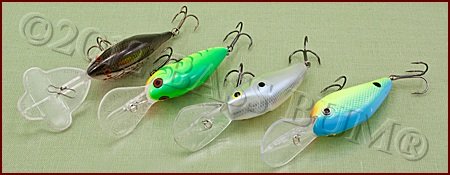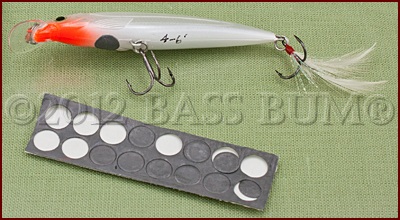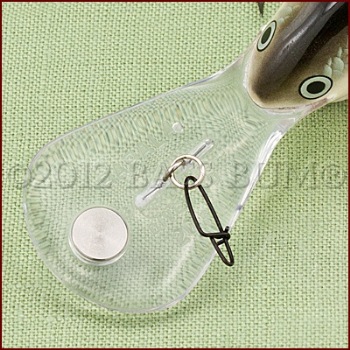Fishing Deep Diving Crankbaits
When The "Big Uns" Are Deep, Crank Up The Deep Divers
Deep Diving Crankbait Variety

How Deep Is Deep?
Deep diving crankbaits have been around (introduced in 1986) and really accepted by bass anglers since the early 1990's. In the years since numerous companies have claimed their deep water crankbaits dive to more than 20'. We'll give them the nod for "sales and marketing" hutzpa but in reality few deep diving crankbaits actually venture that deep.
It can be safely said that most reach the 14' to 18' foot depth. Historically, those that have broken the 20' barrier were able to do so only when used on very light line, usually 8lb test, and when cast very long distances, at least 100'.
Remember, we're talking about casting crankbaits here, not trolling them. Trolling is a completely different story.
Suspend Dots

Now, you can fiddle with your bass crankbaits by adding "suspend dots" or some other lead weight to them and possibly get them down to or below 20'. But this creates the likelihood that the lure won't run true.
It's also a heck of a lot of work getting one that deep and tiring as the dickens crankin' one all day. The water resistance on a lure at that depth is tremendous. That translates into serious wear and tear on you and your gear.
Rapala DT-20 Crankbait With Metal Disc in Bill

Now, having said all this I've used the "Metal" DT20 from Rapala with success. It has a weight embedded in its lip, shown in the picture at right. This one seems to do all it's advertised it will do, at least for me.
Take notice, it will still give your wrist and arms a workout but it comes out of the package ready to go deep and does just that.
Stir Things Up!
The most significant benefit realized with deep diving crankbaits, when not targeting suspended bass, is the ability to fish them at depths "less than their maximum depth". That's what I said, "less than". Why, because this enables you to continually dig into the bottom stirring things up, like a crawfish or bluegill doodling around looking for something to eat. You will also be bumping rocks, stumps and other objects and guess what? This attracts the attention of Mr or Mrs Bucketmouth. Remember, this is a contact sport. Deflection determines most strikes!
Many of the leading professionals bass fishermen will tell you the deep diving crankbaits they use most are those that reach 14' to 18' in depth and which they bounce along bottoms more shallow than those running depths.

What Makes A Good Crankbait Rod and Reel
Combination?
Graphite fishing rods or fiberglass fishing rods? Which makes the best crankbait rod?
- Fiberglass Rod: The argument here is that since these are
less sensitive (some call them dead) than graphite rods the hook set
will be delayed by the angler thereby allowing more time for the bass to
suck in the lure.
- Graphite Rod: With graphite it is felt that the heightened sensitivity will cause an angler to pull the lure away from the bass too quickly. It's also felt that this sensitivity gives the angler an edge as it allows him/her to "feel the bottom" better than with a fiberglass rod.
As with so many things in bass fishing, try both if you can and decide which "works best in your hands". A basic consideration is that whatever rod you choose should have a soft flexible tip and a good backbone. Length should be 7' to 7 1/2'. The long length also contributes to making long casts.
Reel Gear Ratio Is Important Too
When fishing deep diving crankbaits speed is not your friend. In fact, reeling too fast will actually cause your crankbait to rise in the water column, not dive. Follow the lead of the pros. Many of them chose to use medium speed reels that have gear ratios of 5.1:1.
A reel with a large spool capacity is also a good choice because it allows you to make the long casts "necessary" to effectively get your crankbait to its maximum depth.

Fishing Line Diameter And Deep Diving Crankbaits
The lighter the line the deeper goes your lure. Why? Quite simply because it generates less friction against the water. Monofilament line is most commonly used. I choose 10lb mono to crank with most of the time but do go to 8lb and sometimes 6lb when I can get away with it. That would be when I'm not fishing around a lot of submerged brush. The stretch factor of monofilament allows the bass to take the lure deeper and buys me an instant more time for making the usually long and sometimes difficult hook set necessary when fishing crankbaits deep.
Good advice is to stay away from braid when deep cranking unless you're using a very soft tipped rod. The likelihood of pulling the lure from the mouth of the bass is greater with "superlines" as it lacks the stretch of mono.
I've been trying fluorocarbon because of its abrasion resistance and lack of buoyancy, though I have had some trouble making long casts with it. Give it a try and see how it works for you.

Focus On Your Retrieve
Speed
First of all, try and maintain a "medium' retrieve speed with your crankbait lures. You will want to crank a bit faster at the start of your retrieve in order to get your lure down as deep as you can. Then level off to a medium speed as you bring the crankbait through your target area.
Action
A crankbait lure is a lure with built in action. Its very design causes it to wobble or wiggle, roll or shake, maybe even shimmy. A steady retrieve will bring out the lure's action. You can also "enhance" this built in action by varying your retrieve.
However, when fishing deep diving crankbaits the best retrieve is one that is medium fast, steady and bumping structure and cover along the bottom.
While retrieving your crankbait lure keep your rod tip close to the water's surface and off to your side, not pointed at the lure. This will add a little to your depth.
If you want to work your retrieve a bit more you can do either the "Yo-Yo" (sinking lure) or "Worming" (suspending lure) retrieves. Both can be effective deep water presentations.
Yo-Yo'ing is done by raising and lowering your rod tip while you crank which in effect hops the crankbait over structure. This is best done on points where you know bass are suspended. Fan cast both sides of the point cranking the lure "up slope" from deep to shallow and at different angles.
"Worming" a suspending or balsa crankbait is done by lifting your rod tip, as if working a Carolina rig, then dropping it and taking up slack. Personally, I have difficulty feeling strikes with this technique. I suspect many occur as I'm taking up slack and my suspending crankbait is sitting still. Bass are good at quickly taking in a lure and just as quickly ejecting it before an angler can sense the strike.
Again, figure out what works best for you.
The Bite? Sometimes Subtle, Sometimes Jarring
Crankbait bites in deep water vary in their feel.
- Your Rod Loads Up, Feels Heavy
- Your Rod Almost Jumps Out Of Your Hand
- You Lose Complete Contact With The Lure As If Nothing Is There
In each case smoothly sweep your rod to the side and keep reeling. You don't need to "set the hook". Once the bass is hooked up you want to merely keep constant pressure on it and bring it in slowly. Bass are notorious for throwing crankbaits by jumping and shaking their head. So try and keep the fish from jumping even if you must thrust your rod tip under the water as it gets close to the boat.
Bear in mind that a significant number of strikes on crankbaits happen just as the lure begins its upward path to the boat at the end of your retrieve.

When and Where To Fish Deep Diving Crankbaits
Many fish crankbaits year round and are successful doing so. With deep diving crankbaits the fall season is recognized as their premier time. Fall bass fishing finds bass on the move following baitfish that are moving into the creeks. Something about the shorter days and cooling water of fall triggers hyper feeding activity in bass.
In reservoirs bass, both largemouth and smallmouth will be congregating around transition areas of shallow and deep water as they prepare to follow baitfish into the creeks. Look for humps, long points, drop-offs in the mouths of main creeks. Baitfish will be moving from the main lake to the creek arms and bass are hot on their trail. This migration takes several weeks. It doesn't end till the water temperature finally drops to 50°. That's when bass begin moving to their winter haunts.
Start by fan casting the main lake and secondary points deep to shallow, shallow to deep and from every angle as you move into the creek. Focus on those which actively flow into the lake, not still coves or pockets. If you can locate the creek channel focus on its inside bends. If you find one with some sort of cover like stumps, large chunk rock or timber on it you will likely do well as these are places very attractive to bass.
Largemouth bass are also likely to be close to shore, close to cover if the sun is shining, especially as you move toward the more shallow back of the creeks. Here, they will be lurking, waiting to ambush baitfish moving into the creek.
If you find any humps or rock piles work them over from every angle with your deep diving crankbaits. making sure you're bumping the bottom. These features are usually excellent for smallmouth. Bear in mind as well, that in the fall smallmouth bass will suspend above such structure and even along bluff walls.
Smallmouth will be found out from shore a ways in 15-20 feet of water. This time of year smallmouth bass can be found at all depths with the vast majority at 15-16 feet. Perfect depth for deep diving crankbaits. Find structure and cover at that depth and you'll find bass.
Five Primary Considerations For Successfully Fishing Deep Diving Crankbaits
- Long distance casting
- Long, soft tip rods, 7" to 7 1/2"
- Light line, 6-10lb monofilament
- The correct running depth crankbait
- Correct retrieve speed
Return To Crankbaits Fron Deep Diving Crankbaits
